This article is part of our body language guide. Click here for more.
Do you ever notice how some people cross their arms? Does this really mean they’re angry?
According to body language expert Joe Navarro, the torso is the “billboard” of the body1https://www.amazon.com/What-Every-Body-Saying-Speed-Reading/dp/0061438294.
That’s because whether it’s open or closed, whether facing toward us or away, or whether held high or low, the torso can easily be read like a book… IF you know what to look for.
In this guide, we will cover:
- the best clothes to wear to make a great impression (hint: it doesn’t involve a suit or tie)
- how to feel confident and controlled in any situation just by using one pose
- how to get a stubborn boss or client to uncross their arms and open up
- why women touch right below their neck when scared
Let’s dive in!
What’s Your (Body) Type?
First, body language isn’t only about crossed arms or subtle microexpressions.
Let’s play a game, and I’ll show you what I mean.
For the 5 questions below, pick the 3 best words to fill in the blank:
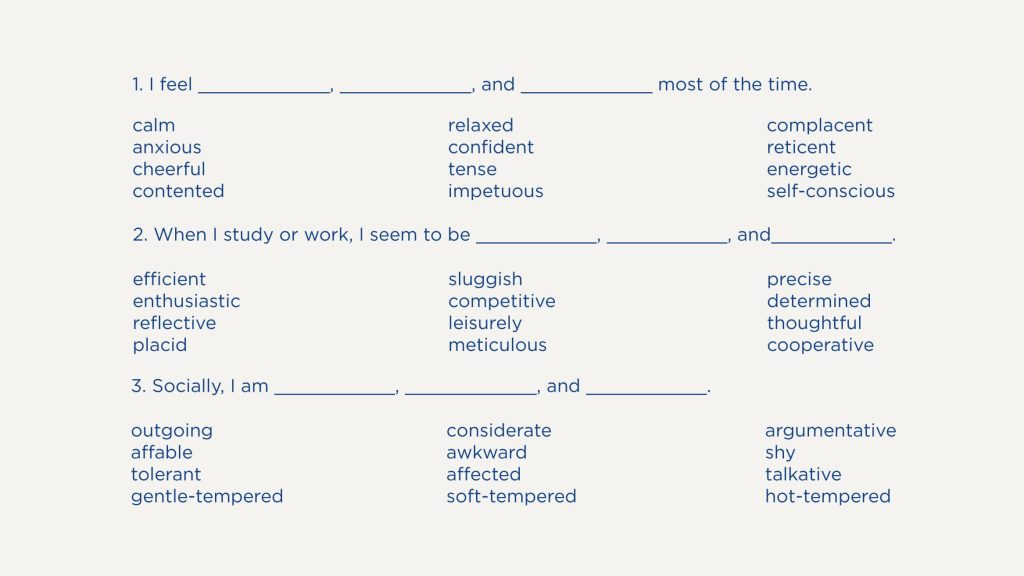
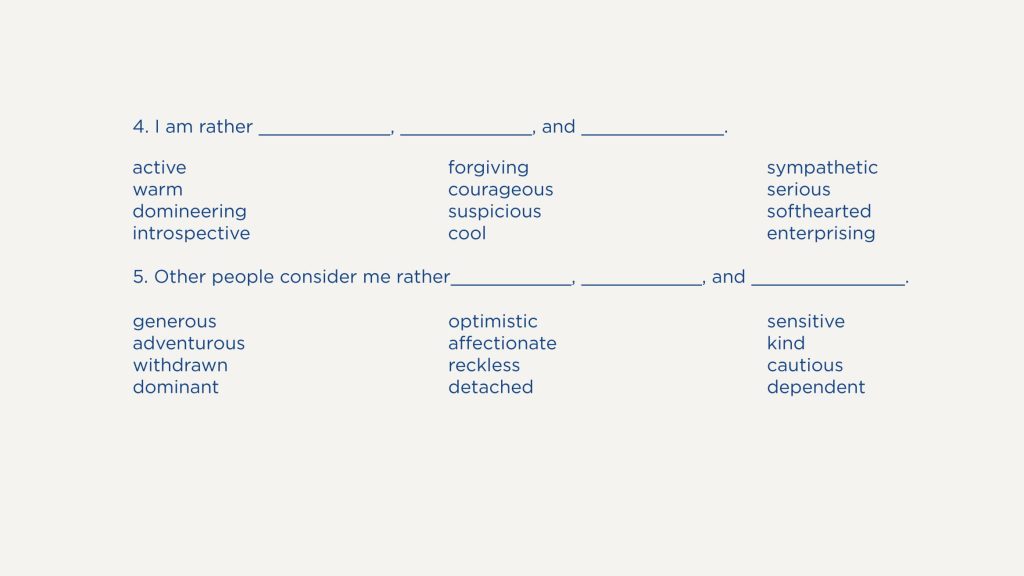
This self-test, based on research, linked personality traits to body types2https://www.amazon.com/Nonverbal-Communication-Human-Interaction-Knapp/dp/1133311598. Now, look at the following chart. Which body type do you relate to the most?
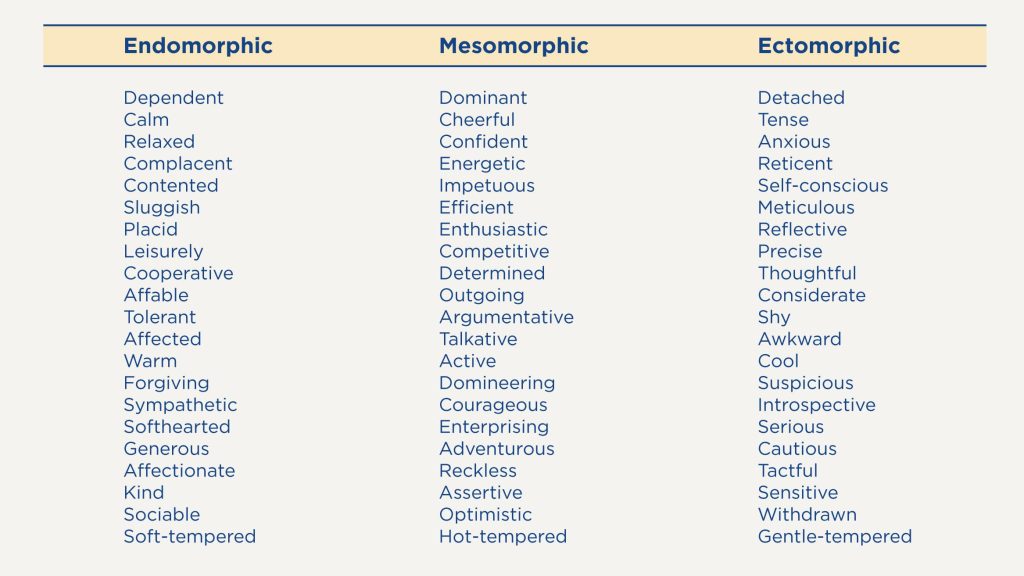
In a nutshell:
- Endomorphs are on the heavier side and are rated as being fatter, older, shorter, more old-fashioned, less strong, less good-looking, more talkative, warmer, more good-natured, agreeable, dependent, and trusting.
- Mesomorphs are well-rounded and can gain or lose weight easily. They’re found to be stronger, masculine, better-looking, adventurous, younger, taller, mature, and self-reliant.
- Ectomorphs are skinnier and lankier. They’re also rated as younger, ambitious, taller, suspicious, tense, less masculine, stubborn and difficult, pessimistic, and quieter.
So, how did you do? I personally found this test to be pretty accurate.
And the cool part is this is just ONE nonverbal observation you can use to “gauge” someone. And while it may not be 100% accurate, if you notice other cues in this list, your judgments will only get better.
Now, onto the rest!
Watch our video below to learn how to read people and decode 7 body language cues:
Positive Torso Body Language
Clothing
Take a look at the chart below2https://www.amazon.com/Nonverbal-Communication-Human-Interaction-Knapp/dp/1133311598. What are your first impressions?
Just like how a chameleon’s colors reflect their emotions, human clothing also gives away hints.
What it Means: Clothing can tell a lot about us1https://www.amazon.com/What-Every-Body-Saying-Speed-Reading/dp/0061438294. It can:
- reflect achievements (police badge, military decoration)
- show off how fit/muscular we are
- attract others
- advertise societal, economic, or occupational rank
- show our religious devotion
- demonstrate if a person is celebrating or mourning
- show high or low status
Women may choose sexier clothes3https://www.researchgate.net/publication/23186272_Changes_in_Women’s_Choice_of_Dress_Across_the_Ovulatory_Cycle_Naturalistic_and_Laboratory_Task-Based_Evidence when close to ovulating. That’s why when it’s time to go to Boogie Night, you’ll find many women outfitted in short skirts and ready to get their flirt on! If you want to read more on what flirtation cues to look for, head on over to female body language cues of attraction.
In addition, clothing can also act as decoration, offer us physical protection, tell us what groups we DON’T belong to, be persuasive, and reflect our attitudes and mood2https://www.amazon.com/Nonverbal-Communication-Human-Interaction-Knapp/dp/1133311598.
Out of all body language to observe on this list, clothing may be the most important.
The Power of Color
What color should you wear if you’re in a competition? In 2005, Hill and Barton conducted a study with 4 combat sports—tae kwon do, boxing, Greco-Roman wrestling, and freestyle wrestling—during the 2004 Olympic games. Contestants were assigned to wear either red or blue outfits.
And the surprising result? In all 4 competitions, contestants wearing red won significantly more fights2https://www.amazon.com/Nonverbal-Communication-Human-Interaction-Knapp/dp/1133311598! Human males and male rhesus macaques also perceive those wearing red as more dominant in competitive situations2https://www.amazon.com/Nonverbal-Communication-Human-Interaction-Knapp/dp/1133311598. This is the power of color psychology.
How to Use it: Want to dress to impress? Dressing nicely does have its benefits. Suits and ties are definitely more influential—in one study, high-status clothing was associated with a higher ability to get bystanders to actually cross an intersection4https://psycnet.apa.org/record/1957-02783-001 when the traffic light is red (I don’t recommend experimenting with this, by the way)2https://www.amazon.com/Nonverbal-Communication-Human-Interaction-Knapp/dp/1133311598.
Other research shows stylish clothes and haircuts may lead us to judge others as more extroverted… and in most cases, our judgments are right1https://www.amazon.com/What-Every-Body-Saying-Speed-Reading/dp/0061438294.
However, science says you don’t necessarily have to don the Rolex. In fact, positive first impressions are more likely if your dress style is similar to the other person’s2https://www.amazon.com/Nonverbal-Communication-Human-Interaction-Knapp/dp/1133311598. So instead of trying to dress to impress…
Dress to belong.
The Flip-Flop Flap
In 2005, Northwestern University’s championship lacrosse team took a photo with former president George Bush at the white house2https://www.amazon.com/Nonverbal-Communication-Human-Interaction-Knapp/dp/1133311598. This stirred major controversy5https://www.nbcnews.com/id/wbna8670164#.Xz-HCS2cZAY, as viewers of the picture criticized the team for wearing flip flops to such a formal event.
Pat on the back
On a scale of 1 to teddy bear, how good of a hugger are you?
Because believe me, I used to be a solid 3. Like the wet, clammy handshake of hugs. Yuck!
What it Means: Luckily, I’ve picked up on some hugging cues, and a big one is the pat on the back. If you ever get stuck in that “uh, should I let go, or continue hugging, or…?” phase, feel for the back pat. This is a great signal to know that the other person is ready to release.
And if you get bombarded with multiple pats? Here’s my hugging rule of thumb:
Treat a hug like a handshake. Give back equally what you receive.
In many Latin American countries, a quick pat-hug is also known as the “abrazo” or brief hug1https://www.amazon.com/What-Every-Body-Saying-Speed-Reading/dp/0061438294. This is similar to the man hug below, common among males.
Man hug or bear hug
This is a louder type of hug with wider arm movements, also commonly known as the “bear hug.”
Observe how 2 college sophomores may perform this man-hug ritual:
Bro A: “Hey, bro!”
Bro B: “Wazzup, bro!”
*Both lean in while their arms are wide, close in, and give a firm slap on the back as they step back to continue their conversation*
What it Means: The man hug “has that little of physical roughness to it, which is also consistent with men,” says Adam Galinsky6https://www.gq.com/story/hugs-and-back-pats, a social psychologist.
It’s that type of greeting that says “I like you” in a more intimate but still socially acceptable and platonic way. Man hugs are the type of hug that strikes the perfect balance between masculinity and warmth.
In most man hugs, the pat is the signature hug-ending cue. The pat can also be seen in wrestling, when one guy taps their back to signal that they want to end a grapple. This acts as a distancing behavior that signals to other men that they want to be intimate but not too intimate.
How to Use it: Depending on the situation, the man hug can have 4 different levels of intensity:
- Level 1: The quick in-and-out. This man hug is similar to the abrazo and can be seen between 2 men who are decent-enough friends. It may even be accompanied with a bro shake. You won’t normally see these men hug any other way… at least not in public.
- Level 2: This is the gentle, almost romantic-like man hug. The embrace may last for 2 seconds or more. It can be seen with best man-friends who have been separated for many months. But don’t tell the guys that it’s romantic—you’ll probably get a hissy fit and constant denial in return.
- Level 3: The enthusiastic hug. This bro hug can commonly be seen at sports games or other competitive events and is usually done by the winners. The stronger and tighter the hug, the more manliness is shown. You may also hear many grunts and screams during this hug.
- Level Awkward: This is the awkward “should I go for the fist bump or hug” type scenario. This man hug can usually be seen around college campuses, especially with starry-eyed freshmen and recovering awkward people.
The chest touch
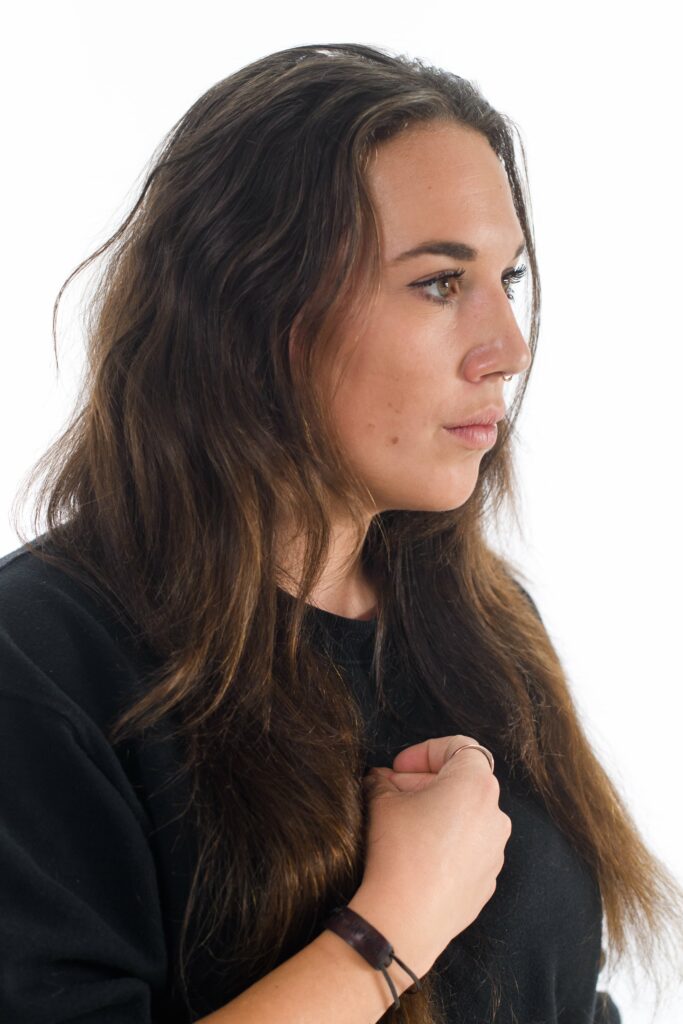
What it Means: If a woman is covering her chest, it can mean that she is feeling vulnerable or touched.
For example, when Steve Harvey announced the Miss Universe winner in 2015, he first announced Miss Colombia. However… here’s the big blunder:
The real winner was actually Miss Philippines. Yikes! Watch her body language as Miss Philippines realizes she’s actually the winner (timestamp 3:23):
Another variation of this gesture is having both hands touching the chest. This may be an indication of trust, where the person is usually telling the truth, but the other person doesn’t believe them or isn’t buying it.
How to Use it: If you notice someone touching their chest during an interrogation, this may mean they are feeling distressed but doesn’t necessarily mean they’re lying. Watch out for other lying cues to determine their true motives.
Belly turned toward you
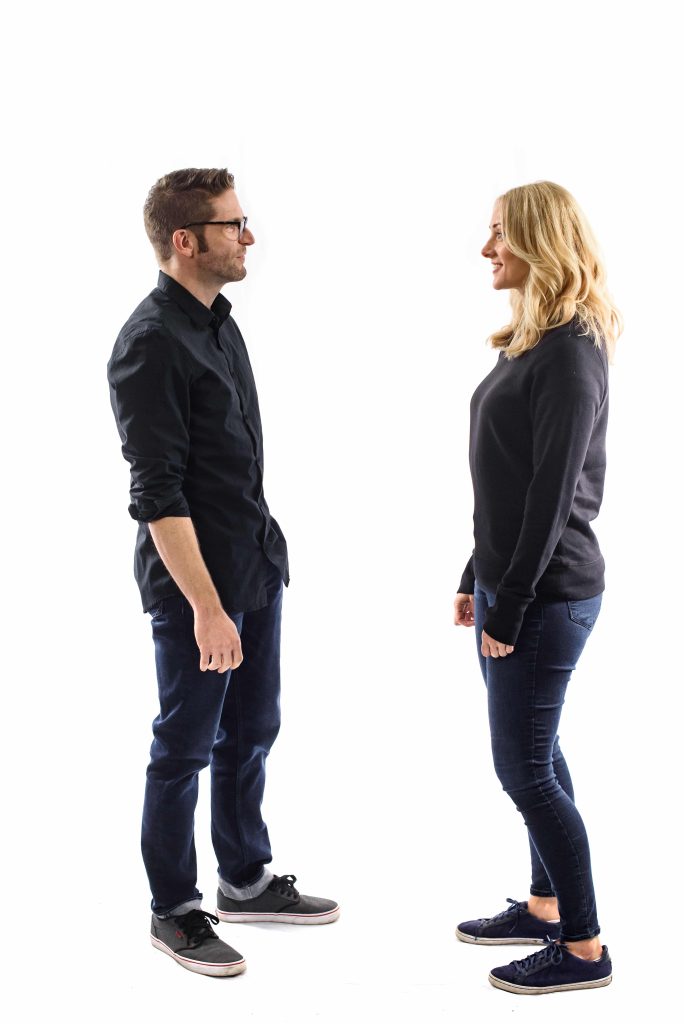
You’ll typically see this gesture during conversation. Watch for the belly, as it’ll likely indicate someone’s desires.
What it Means: Your belly button usually faces the person you most like, admire, or trust, says Chris Ulrich7https://www.glamour.com/story/8-ways-to-seduce-a-guy-with-yo, senior instructor at the Body Language Institute.
On a special note, if a person’s torso is pointed toward you but their feet are not, it may mean that they will be attentive only for a short time1https://www.amazon.com/What-Every-Body-Saying-Speed-Reading/dp/0061438294. Their feet are good indicators that they may want to continue walking to a different destination or doing whatever they were doing in the first place.
Pride pose
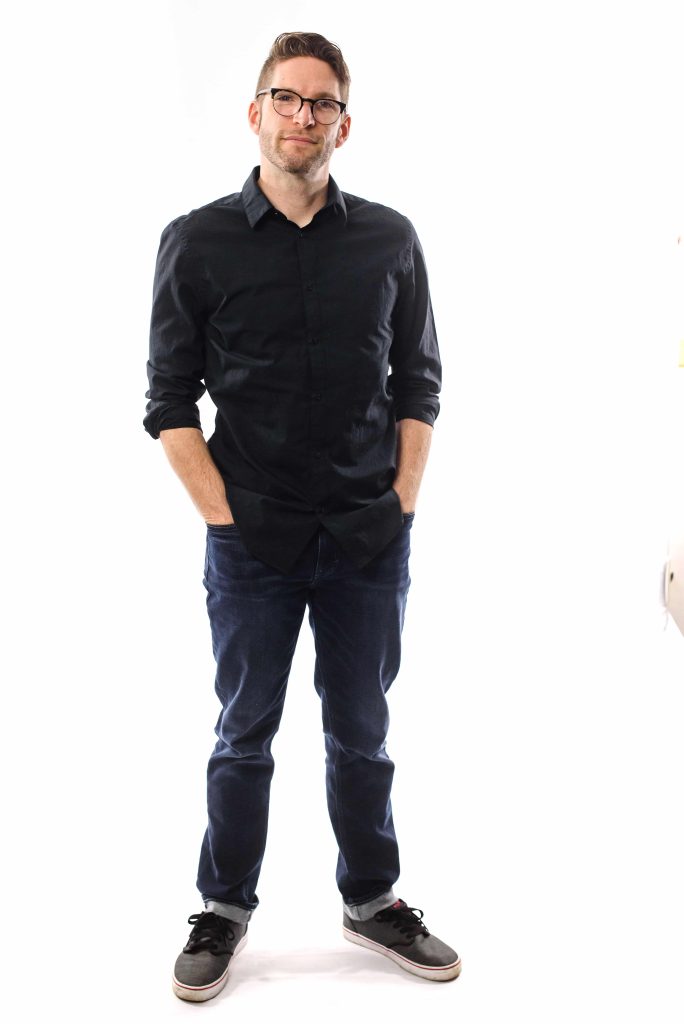
The pride pose is characterized by the chest sticking out and shoulders rolled back.
What it Means: This is the pride pose, and it signals ultrahigh confidence. Jennifer Lawrence is a great example of someone who exudes confidence, and we love to be around, to look at, and to adore confident people:
- She is in the universal pride pose. Researchers at the University of British Columbia found8https://news.ubc.ca/2008/08/11/ubc-study-of-olympic-athletes-shows-that-pride-and-shame-are-universal-expressions/ that athletes across cultures stand broadly when they win a race and shrink down in defeat. When we look at someone’s photo, we are trying to decide if they look more like a winner or loser—are they standing broadly and taking up space, or are they contracting their body?
- Her wide smile and outward look signal optimism and forward thinking. A genuine happiness micro expression is universal. Dr. Paul Ekman found9https://www.amazon.com/Unmasking-Face-Recognizing-Emotions-Expressions/dp/1883536367 that across cultures, when we are happy, we smile, and that smile reaches all the way up into our eyes. We do this to signal friendship—a smile is the only facial expression that can be seen from 200 feet away!
Want to know who else is good at pride posing? Kamala Harris. Check out my body language video where I take a deep dive at how she exudes confidence:
How to Use it: The next time you’re feeling down or unconfident, strike a pride pose! This not only makes you LOOK confident, but keeping your head up high and shoulders back forces you into an upright position, lifting your mood in the process. Check out the science behind power posing here.
Negative Torso Body Language
Hands crossed over chest

Do you ever notice when you cross your chest with your arms?
For example, I was walking into the kitchen the other day, and what do you know? I found a sock in the middle of the floor.
That’s right… a dirty, rotten, good-for-nothin’ SOCK on the ground (not the first time!). I immediately turned to my husband Scott and accused him of this near-felony-level crime.
And the funny but expected part? He quickly crossed his arms before he gave his excuse.
Exactly as I expected he would.
What it Means: This may seem obvious, but crossed arms can mean someone is closed off. The torso is actually the first part of the body we tend to cover up when threatened.
You may see someone crossing their chest whenever they’re taking a defensive position toward a particular topic, person, or situation… or in my case, a dirty-sock dilemma.
And in a business setting, this is KILLER to see. Say you’re pitching a client, and your client immediately crosses their arms. Was it something you said? Was your price too high? Did they not like your idea? It may be likely that there’s suspicion or something doesn’t “connect” with them.
In this case, it may be best to take a step back and identify exactly what’s causing them to close.
Crossed arms is also the same gesture as self-soothing or hugging yourself, which is why Navarro calls this the “self-hug.” In other cases, you’ll see crossed arms when a person feels a need for reassurance or support.
For example, if you see a person crossing their arms after you have given your opinion, this might be a good sign to back off, use less aggressive or direct body language cues, and take into account their emotions.
Navarro often sees women on campus during their first few days of class holding their notebooks or bags across their chest as they walk into class.
As the semester wears on and their comfort levels increase, they will eventually shift their notebooks and carry them at the side.
However, on test days, this chest-covering behavior tends to increase, even among male students.
How to Uncross Arms: Do you have a stubborn client you’re trying to impress, but they’re stiff and closed tightly? An easy trick is to use a coffee cup10https://www.amazon.com/Definitive-Book-Body-Language-attitudes/dp/1409168506. Simply give them a coffee (or notebook/other document), and they will be forced to uncross to hold the item. This will get them to immediately open up to your proposal!
Body chill
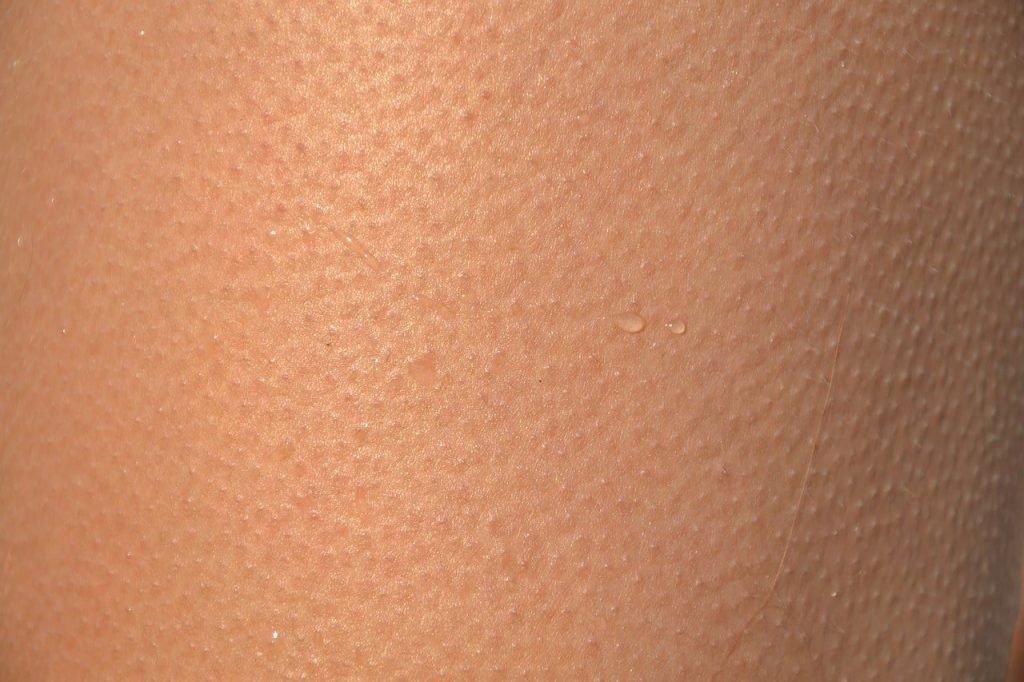
Body chill is the sensation someone gets when they’ve got the goosebumps. They may shake, shiver, shimmy, or any combination of the above.
What it Means: Stress can cause individuals to literally “feel” cold1https://www.amazon.com/What-Every-Body-Saying-Speed-Reading/dp/0061438294. That’s why you may also feel reduced stress if you take a long, warm bath11https://www.healthline.com/health/chronic-pain/hot-bath-benefits-sento-furo-japanese-bathing. If you notice a person shivering, most likely this is an automatic response.
They may be cold, but blood also flows from larger muscles when people feel threatened or anxious. That’s why you may also see the body chill clustered together with a fear microexpression.
Hand on chest
Not long ago during my people-watching routine at the airport, the lady sitting across from me at the boarding gate answered her phone. Her expression didn’t change, but I could clearly see a hand fixed on her chest.
Although I couldn’t hear her, my gut instinct said she just learned some bad news. Quickly after the call, she got up and left. I never saw her again.
What it Means: During tense situations, a person may press on their chest or near this area with the thumb and middle finger (or sometimes all fingers) to relieve sudden pent-up stress12https://www.amazon.com/Dictionary-Body-Language-Field-Behavior-ebook/dp/B075JDX981.
This is an effective pacifier, as if trying to “calm down” a suddenly beating heart. The harder a person presses on the chest, the worse the emotional reaction. You likely won’t see this gesture on the street, but on the rare occasion you do, this is an important cue to look for during high-tension events.
The chest rundown
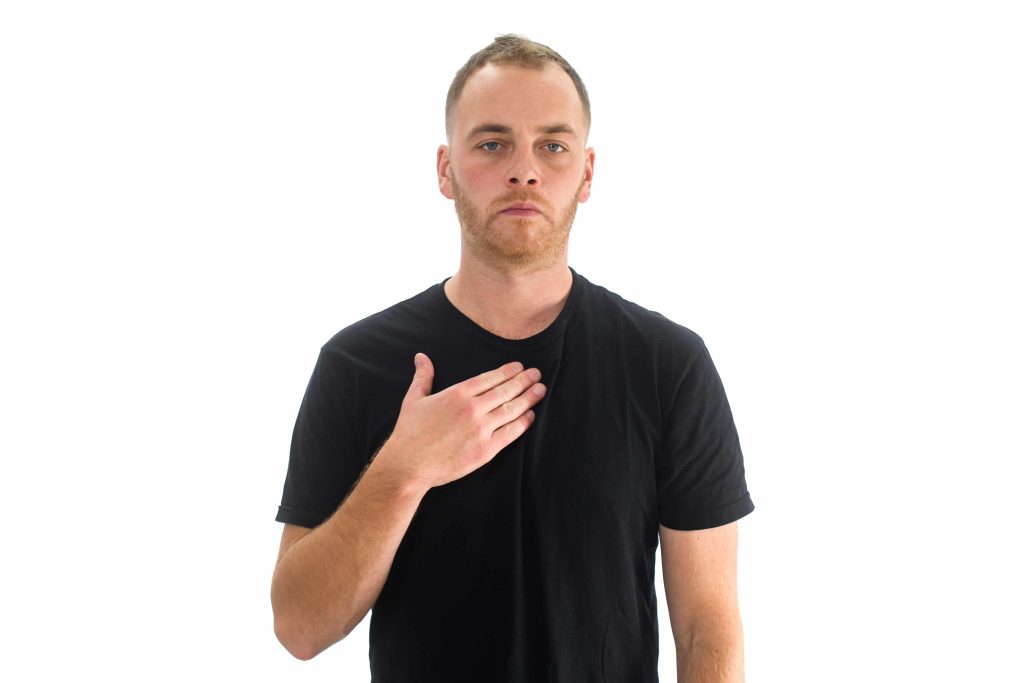
What it Means: Similar to chest pressing, running hands down the chest is a pacifying body language cue. It signals nervousness and a need for reassurance or supportive touch.
Chest puffed out
What it Means: Before getting into a fight, our bodies want to get as big as possible.
This happens for 2 reasons:
- First, when we are bigger, we look more imposing to our opponent—and could possibly scare them off.
- Second, the more space our bodies take up, the more testosterone we produce.
According to Amy Cuddy at Harvard Business School, testosterone (for both men and women) is the strength hormone. It not only makes us perform better and think faster, but it also makes us feel more confident—essential for winning a fight. So someone who is about to act out with violence will often puff out their chest and hold their head high to look as big as possible.
How to Use it: When you see this cue, don’t cower. While you don’t want to puff up like them (this challenges them), you don’t want to cower either. This will not only make you feel worse, but it might encourage them to see you as a weak opponent.
You are much better off standing your ground and holding your hands out and open with your palms up. This is the universal “non-threatening” gesture and signals to them you don’t want to fight.
Buttoning up jacket
What it Means: If you notice someone buttoning up their jacket, this may not only mean they’re cold. It can also mean 3 other things1https://www.amazon.com/What-Every-Body-Saying-Speed-Reading/dp/0061438294:
- They’re uncomfortable. Buttoning a jacket is a more secretive way of crossing the arms. The end result is the same—the torso is behind another object and not open.
- The environment is formalized. This can be seen whether entering a new formal environment or aiming to create more formality from an informal one.
- They are showing deference to a boss. An unbuttoned suit can look messy, while buttoning up is the safe and professional way to go.
How to Use it: In a high-profile event, it’s always a good idea to overdress rather than be underdressed—it’s much easier to dress down in an event than dress up. If you’re at a formal event, button it up to keep things professional. If you’re on a playdate and want to notch up the fun and flirtation, consider informalizing the setting by unbuttoning.
Heavy breathing

What it Means: A sudden change toward heavier breathing can signal storing oxygen for fight or flight. Watch for this cue before someone engages in a fight. You might notice their nostrils flaring, as well as their breathing rate increase.
The telltale sign can be seen with the greater rising and falling of the chest. You may not even notice this, especially if they’re wearing a thick jacket or you’re far away. However, it’s especially noticeable if the person is relaxed and leaning back on a chair.
Stretching
How do you stretch? I love reaching my arms out, stretching my torso as wide as possible.
What it Means: When we become stressed, our body adapts into its fight-or-flight response, which creates tension. The tension is created in our shoulders, lower back, and our head.
Stretching disrupts that tense physical response to stress and provides relief. Stress can also restrict blood flow throughout our bodies, while stretching can counterattack by increasing blood flow. This helps bring back that circulation and relieve that tense ache in our muscles caused by stress.
How to Use it: As soon as you wake up in the morning, take a minute and stretch to get that blood flow circulation going and give yourself a boost to start your day. Throughout the day, do stretches to keep fighting the tension brought on by stress.
Chest pounding
You likely won’t see this gesture in the office or walking down the street, but you may spot it before a fight starts.
What it Means: The phrase “pounding your chest” comes from the apes because apes often show chest pounding before fighting. Ian Redmond13http://www.bbc.com/earth/story/20150529-what-do-gorillas-talk-about, a tropical field biologist, says an ape will perform a “rapid chest beat and then finishes off the display by hitting the ground or tearing off a sapling, or if someone’s sitting there, maybe thumping that someone.”
How to De-Escalate it: First, don’t make eye contact. You don’t want to raise yourself taller to compete with the individual, so shrink down and make yourself as small as possible. Don’t talk back, just walk away to have your best chances to avoid a fight.
Torso turned away
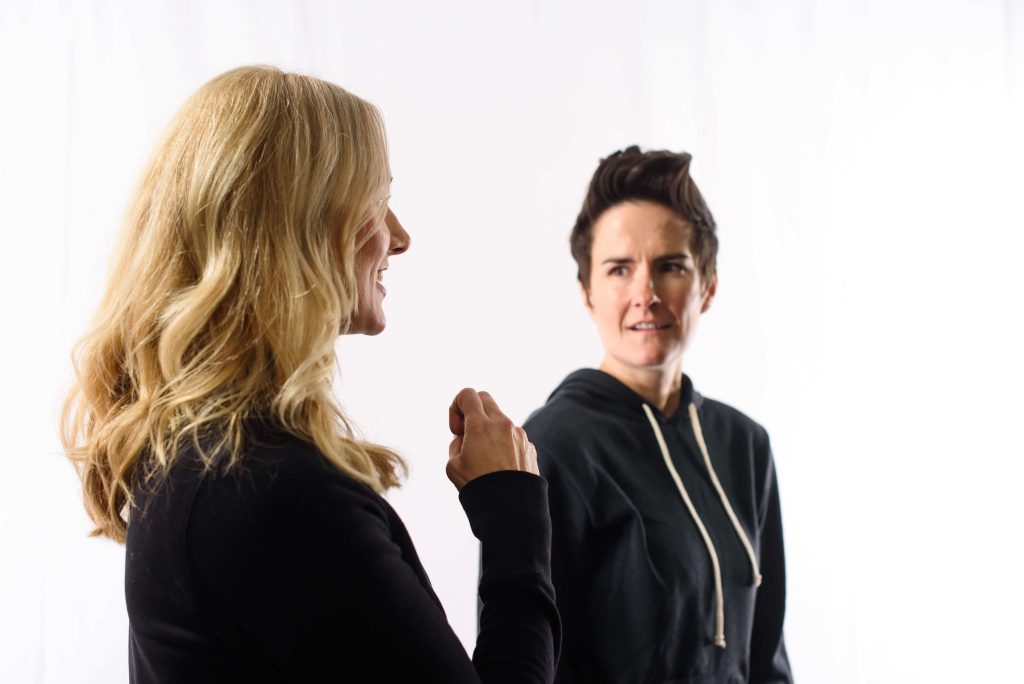
What it Means: During a conversation, pay attention to the direction the torso is turned. If it’s pointed toward the exit, with feet pointing the same direction, they may want to leave.
And if you’re talking to your crush and he’s torso-turned toward your friend… perhaps he’s just not that interested in you. However, keep in mind to pay attention to other flirtation cues as well.
Torso tilting is also something that basketball players do when they want another player to engage with them. You will notice the players sometimes will aim their torso at another player a split second before they pass to them. This nonverbally tells their teammate to get ready.
Fun Fact: Buttonholding
The word “buttonholding” originated from previous centuries from taking hold of a person’s buttons while talking to them so they couldn’t escape a conversation12https://www.amazon.com/Dictionary-Body-Language-Field-Behavior-ebook/dp/B075JDX981.
So what happened to the buttonholding trend? In 1808, a man named Charles Lam found himself button-held one day by a rather eager gentleman… So what did he do? Charles simply “cut off the button.”
So much for a climax!
The body guide

This small gesture is done when someone places a light hand on another person’s back or shoulder to “guide them.” You may see this gesture when someone guides another through a door, for example.
What it Means: Little do people know, but this is a high-dominance cue. It’s akin to how a parent would direct a child, and when done wrongly, can have consequences.
For example, in the 1990s, one widely reported incident was when one of the Queen’s hosts placed a guiding hand on her back during a royal visit to Australia14https://www.amazon.com/Peoplewatching-Desmond-Morris-Guide-Language/dp/0099429780.
How to Use it: Gently place your hand on someone’s back when exiting a building to subtly show power. This is best done when your power is already established, or you might end up in a power fight with another dominant contender. You can also do this in a relationship to establish dominance and authority over the other.
In the following video, you can see former US President George W. Bush shaking hands with former British Prime Minister Tony Blair. You can see Bush giving Blair 3 taps on the back while leading him down the hall. Bush is nonverbally telling Blair he’s a “good boy.” It’s clear who has the power here:
Nervous sweating
According to Ivan Ong15https://qz.com/quartzy/1269283/no-one-knows-why-we-sweat-when-were-nervous-but-scientists-have-a-gross-idea, head of research at an antimicrobial company, there’s a difference between anxious sweat and exercise or heat sweat.
Why?
A 2009 study16https://journals.plos.org/plosone/article?id=10.1371/journal.pone.0006415 funded by the US military explains:
- Sweat was collected from 20 individuals, both from running on a treadmill and right before skydiving for the first time.
- Some lucky volunteers were asked to randomly smell the sweat.
The result?
The sweat collected right before skydiving triggered the amygdala and hypothalamus—two regions associated with fear—in volunteers’ brains. Nothing was triggered when the volunteers smelled the exercise sweat. This means…
We can literally smell fear.
Sounds crazy, right?
How to Spot it: People sweat differently—through the armpits, on the face, or even in some other *ahem* covered areas. If you notice sweating, this also doesn’t mean that someone is automatically lying. Sweating is something that getting a baseline for would really help, since people sweat differently due to genetics.
The Sweaty Terrorist
In the case of the “Millennium Bomber”, Officer Diana noticed Navarro – excessive sweating from Ahmed Reesam as he entered the United States from Canada.
When Officer Diana questioned him, Reesam tried to flee but was captured. Later, they found explosives and timing devices in his car. He was then convicted of plotting to bomb Los Angeles airport.
Upset stomach
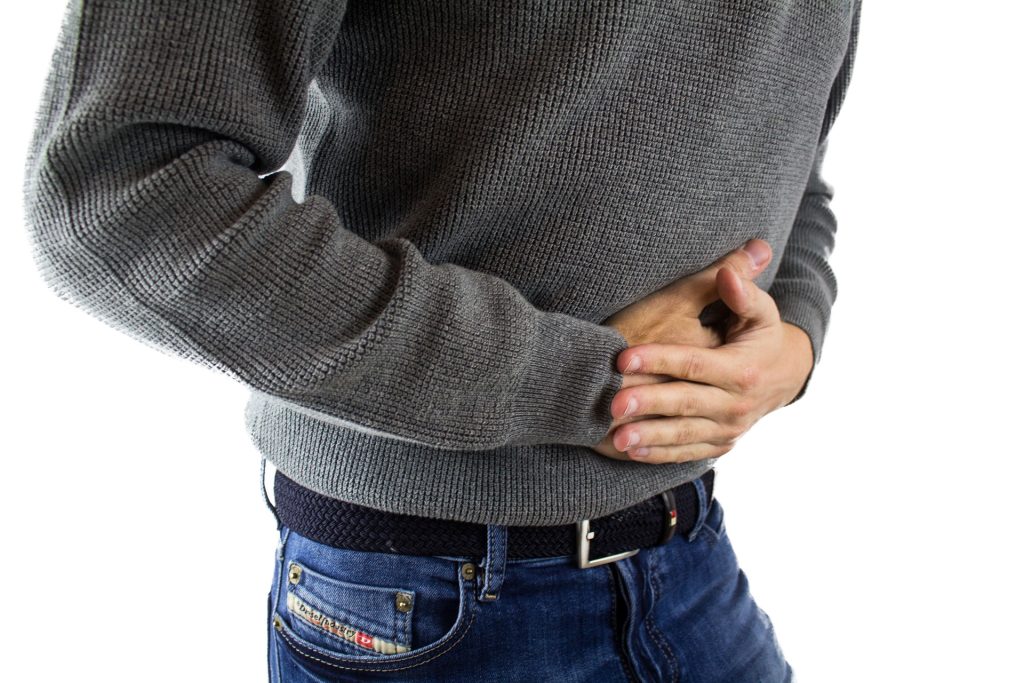
A more subtle cue is the “butterflies in your stomach” feeling you get when something worrying or stressful occurs. I used to get this before ALL my high school dates. Talk about nerve-wracking.
Here’s why it happens:
When you hear bad news, you become upset. This diverts blood away from the digestive system and into the heart and limb muscles, preparing you for escape.
And since your digestive system doesn’t have much blood now, it “feels” tight because it isn’t able to digest efficiently.
Pretty simple, right?
So while an upset stomach is an indicator your own stomach is upset, how do you tell when it happens to others?
You may commonly see people vomit after traumatic events or release other… err, fluids. Especially during emergencies, when there’s no time for digestion.
Runners often experience something called “runner’s diarrhea17https://newsnetwork.mayoclinic.org/discussion/how-can-i-prevent-runners-diarrhea/#:~:text=Runner’s%20diarrhea%20is%20characterized%20by,runner’s%20diarrhea%20isn’t%20clear.” due to pre-run stress and anxiety. This is the body’s way of “lightening the load” and preparing for escape or physical conflict.
So you can’t really tell when someone has an upset stomach, so it’s best to look for other telltale signs like uncomfortable postural shifting or tightly crossed legs.
Splaying
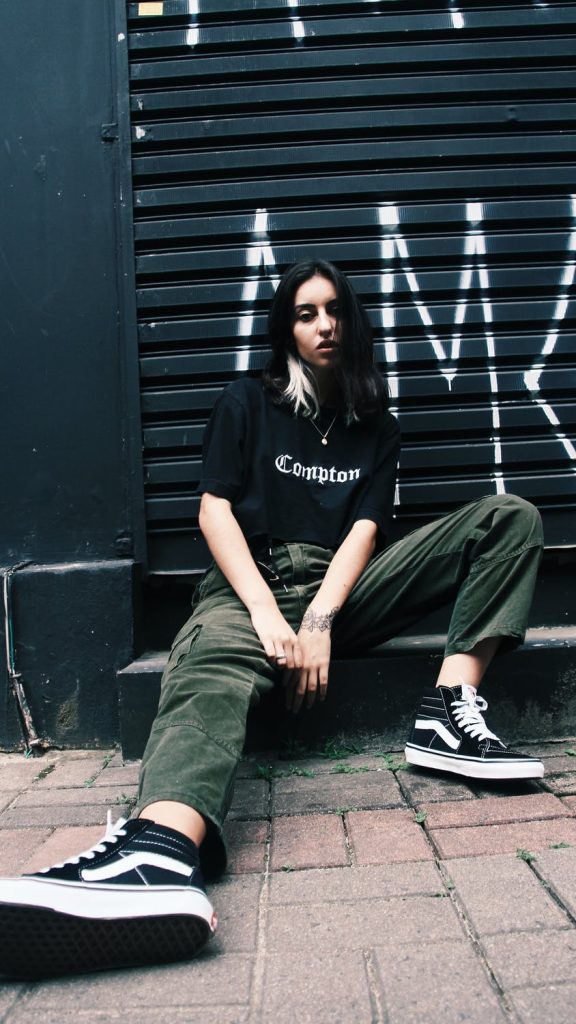
I have something to admit:
As a kid, I was a HUGE splayer.
I’d splay on my bed, at my desk, in class, and if my parents would’ve allowed me, heck, I would’ve splayed at the dinner table.
But let me tell you: I’ve learned.
Over the years of splaying, I learned just what kind of message my rebellious teen self was asserting. And I can’t help but cringe.
What it Means: Splaying is commonly used as a sign of disrespect against authority. In my case, I was channeling my teenage angst toward society for not accepting my inner darkness.
The truth is, if allowed, teens who splay will lose respect for you. And if they grow up and continue this splaying behavior, they may splay inappropriately as an adult…
And if one day they splay in the workplace, they might find themselves splayed on the sidewalk the next day with a “Feed the Homeless” sign.
How to Use it: Are you a parent and see your child splaying?
Luckily, for most people, splaying is like sucking the thumb. They will just grow out of it. However, some don’t. Here’s how to effectively counter and discourage this rebellious body language:
- Start by sitting next to them or standing close. This invasion of their space shows them they can’t dominate you.
- Push back against their territorial advance. This can even mean inching closer or using more dominant cues yourself to limit their space.
If you allow them to splay, they will continue to take up space and dominate, effectively “overpowering” you. Over time, you will likely see splaying occur less or take up less space. This is a good sign your efforts are working and to continue the territorial wins!
I want to thank you SO much for reading!
This guide is part of my body language guide, and if you loved this article, feel free to read more in the series!
Did you learn anything new from this article? Let me know in the comments below!
Crack The Code on Facial Expressions
The human face is constantly sending signals, and we use it to understand the person’s intentions when we speak to them.
In Decode, we dive deep into these microexpressions to teach you how to instantly pick up on them and understand the meaning behind what is said to you.
Don’t spend another day living in the dark.
Side Note: As much as possible we tried to use academic research or expert opinion for this master body language guide. Occasionally, when we could not find research we include anecdotes that are helpful. As more research comes out on nonverbal behavior we will be sure to add it!
This article is part of our body language guide. Click here for more.
Article sources
- https://www.amazon.com/What-Every-Body-Saying-Speed-Reading/dp/0061438294
- https://www.amazon.com/Nonverbal-Communication-Human-Interaction-Knapp/dp/1133311598
- https://www.researchgate.net/publication/23186272_Changes_in_Women’s_Choice_of_Dress_Across_the_Ovulatory_Cycle_Naturalistic_and_Laboratory_Task-Based_Evidence
- https://psycnet.apa.org/record/1957-02783-001
- https://www.nbcnews.com/id/wbna8670164#.Xz-HCS2cZAY
- https://www.gq.com/story/hugs-and-back-pats
- https://www.glamour.com/story/8-ways-to-seduce-a-guy-with-yo
- https://news.ubc.ca/2008/08/11/ubc-study-of-olympic-athletes-shows-that-pride-and-shame-are-universal-expressions/
- https://www.amazon.com/Unmasking-Face-Recognizing-Emotions-Expressions/dp/1883536367
- https://www.amazon.com/Definitive-Book-Body-Language-attitudes/dp/1409168506
- https://www.healthline.com/health/chronic-pain/hot-bath-benefits-sento-furo-japanese-bathing
- https://www.amazon.com/Dictionary-Body-Language-Field-Behavior-ebook/dp/B075JDX981
- http://www.bbc.com/earth/story/20150529-what-do-gorillas-talk-about
- https://www.amazon.com/Peoplewatching-Desmond-Morris-Guide-Language/dp/0099429780
- https://qz.com/quartzy/1269283/no-one-knows-why-we-sweat-when-were-nervous-but-scientists-have-a-gross-idea
- https://journals.plos.org/plosone/article?id=10.1371/journal.pone.0006415
- https://newsnetwork.mayoclinic.org/discussion/how-can-i-prevent-runners-diarrhea/#:~:text=Runner’s%20diarrhea%20is%20characterized%20by,runner’s%20diarrhea%20isn’t%20clear.
How to Deal with Difficult People at Work
Do you have a difficult boss? Colleague? Client? Learn how to transform your difficult relationship.
I’ll show you my science-based approach to building a strong, productive relationship with even the most difficult people.
